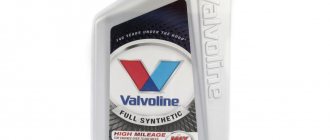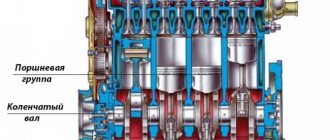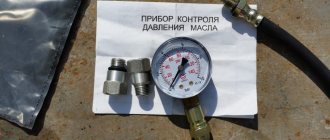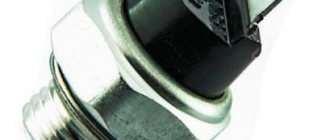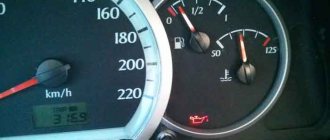Dashboard with oil pressure light on
There are cases when on the dashboard of a car, immediately after starting the engine, as well as at idle speed, the oil pressure warning light on a VAZ 2110 suddenly lights up. At the same time, it is unlikely to be possible to find out the reason without opening the hood; moreover, there are several reasons for this If the oil pressure light on the VAZ 2110 comes on, you can be sure of only one thing - something has already failed in the engine of your car or is just beginning to fail.
Moderate causes or maybe sensor
Here it is worth mentioning options from which any driver is not protected, that is, practically not to blame.
SO: 1) The pressure sensor has failed - I already wrote about such a case on my AVEO, this is a trivial problem with CHEVROLET engines, if the engine is not warmed up, the oil simply “breaks through” the sensor, and it starts to “flow” - it does not show the correct data, even if your level is normal, it will constantly signal you. What to do - just change it! Many cars have this problem, and therefore in winter we warm up the engines at idle - a must! It manifested itself like this, here is the video.
2) Wrong oil! Rarely, but it happens. Now, however, all manufacturers indicate the tolerance standards that need to be poured into their motor (for example, 5W - 40, 5W - 30), however, there are those who “don’t understand” who can fill in a brand and tolerances that are not designed for your unit (for example, 0W - 20) , what's happening? Such oil is either very liquid, or, on the contrary, very thick, the pressure begins to jump from normal - the pressure lamp lights up! Therefore, we are not being “wise”, we are pouring what the doctor ordered. If you don’t know which one, go to the forums for your model, everything has already been written there a long time ago.
3) Antifreeze or antifreeze gets into the engine crankcase. Unfortunately, this is not uncommon - the gasket between the engine block and the head breaks, and the coolant simply flows into the oil. Accordingly, the lubricant loses its properties, becomes liquid and can no longer withstand the required pressure (that is, it drops below 0.4 kgf/cm2). This malfunction is easy to determine; your coolant level will constantly drop, and there will be no drops under the car anywhere. And the oil level is constantly rising! In general, urgent measures need to be taken, otherwise the engine will “knock.”
These are reasons that already require intervention in the inside of the unit, but they are moderate in severity, some are the most complex.
VAZ 2110 instrument panel oiler
- To the beginning of the forum
- Forum Rules
- Old design
- FAQ
- Search
- Users
When the oil light comes on, IMHO, when the oil pressure sensor is working,
it means the oil pressure in the engine is low.
Moreover, it does not always burn, but often.
- under what conditions? (cold engine at idle, hot engine at idle, at high speeds, during sharp maneuvers, when driving uphill or downhill.)
1. Oil (it has become too liquid. I heard about the instability of Lukoil oil, people don’t pin it) 2. Filter (oil) 3. Low oil level (maybe the dipstick is crooked?) 4. .
The oil can on the dashboard is burning. What does this mean?
To clarify, the light is not on the instrument panel (red - meaning low oil pressure), but on the dashboard to the left of the clock below the radio (yellow - I don’t know what that means). And it lights up very suspiciously. At some point it starts to burn stubbornly (turn the engine on and off - no use). At some point, it stops lighting up and may not be noticeable for several days. Moreover, it was not possible to find an obvious connection between the lighting of the light bulb and some external conditions (warm-up or cool-down engine, tilting or not tilting the car).
The oil level, as I already said, is normal, the oil was changed 6000 km ago.
In general, what should this light bulb mean? Options 2:
1. insufficient oil level (dipstick lying?) 2. excessive oil contamination (like on new BMWs - I honestly can’t believe that the 10 has this).
To clarify, the light is not on the instrument panel (red - meaning low oil pressure), but on the dashboard to the left of the clock below the radio (yellow - I don’t know what that means). And it lights up very suspiciously. At some point it starts to burn stubbornly (turn the engine on and off - no use). At some point, it stops lighting up and may not be noticeable for several days. Moreover, it was not possible to find an obvious connection between the lighting of the light bulb and some external conditions (warm-up or cool-down engine, tilting or not tilting the car).
The oil level, as I already said, is normal, the oil was changed 6000 km ago.
In general, what should this light bulb mean? Options 2:
1. insufficient oil level (dipstick lying?) 2. excessive oil contamination (like on new BMWs - I honestly can’t believe that the 10 has this).
If the right side of the car is higher than the left when parked, the oil level sensor usually triggers. Check the slope.
Source
Review and opinions on the radar detector SUPRA DRS-i57VST Belka
Why is the oil pressure light on VAZ 21142115 causes and solutions
A series of radar detectors from the Supra company, bearing the self-explanatory name “Belka”, is intended, among other things, to detect signals from the Strelka complex. Recently, this traffic police radar has become widespread due to its wide capabilities for detecting speed violations and the difficulty of detecting it with detection means. The number of stationary complexes is constantly increasing, especially in big cities and on major highways, and this can cause a lot of trouble for drivers.
The SUPRA DRS-i57VST radar detector confidently detects Strelka CCDDAS in any conditions of use. This applies to difficult terrain, weather conditions, and a large number of garbage radio signals. Signals are detected at distances of approximately 1000 meters. Many radar detectors provide detection of Strelka at long distances, but 1000 meters under normal conditions is quite enough to bring the vehicle’s speed into compliance with traffic regulations.
Naturally, Strelka is far from the only radar that is used by traffic police inspectors to control the speed limit on Russian roads. The radar detector is capable of detecting the activity of most radars in all frequency ranges.
Minor problems may arise for the device when detecting short-pulse speed control devices operating in the “Short Pulse” (Ka) and “Instant-On” modes. In these cases, there are likely to be omissions in signal detection or late detection, which does not allow drivers to take timely measures to reduce speed.
The radar detector demonstrates good results in detecting radars operating both “in the face” and “in the back” of the car. Traffic police inspectors often use speed measurements of a moving vehicle, since not all radar detectors are capable of detecting the activity of devices operating in this mode.
The manufacturer has not stated the ability to detect signals from the “Robot” multiradar. However, in some cases, the gadget is capable of detecting such radio signals and warning the driver about it.
The gadget has good results in detecting lidars. Optical radar signals are generally very difficult to detect. This is due to a number of properties of the laser beam: very short pulse time, narrow directionality, which does not allow it to be detected in cases where it does not pass directly through the receiver lens of the device. Among inexpensive radar detector models, the reliability of detecting lidar signals can be considered quite acceptable.
One of the important criteria for evaluating any radar detector is the clarity, accessibility and reliability of warning the driver about the detection of dangerous signals. In the SUPRA DRS-i57VST radar detector, this system is represented by a combination of visual and audio signals.
The six-segment LED display provides information about the frequency range and relative power of the detected radio signal. Multi-colored symbols are clearly visible and make information easy to understand. To make them more comfortable to read in different lighting conditions, it is possible to change the brightness of the display in three steps.
The sound alarm is a backup way of notifying the driver of the presence of danger. If necessary, its volume can be set based on your own preferences, up to complete shutdown. Based on the sound intensity, you can estimate the distance to the source of radio signals.
Additional comfort during use is provided by the automatic sound muting function. When a dangerous radio signal is detected, an audible signal sounds at maximum volume and continues for several seconds. Then the volume gradually decreases until it turns off completely. This allows the driver to receive the necessary information in a timely manner and not be distracted by turning off the sound volume.
Another important indicator of a good radar detector is its level of noise immunity. The SUPRA DRS-i57VST radar detector is quite well protected from the effects of non-police radio signals.
Working in one of three modes (“city 1”, “city 2”, “highway”) allows you to change the sensitivity of the receiver, achieving the most reliable operation and the minimum number of false reactions. In addition to selecting the operating mode, the user can disable certain frequency ranges from scanning, which also improves the quality of the gadget’s operation.
The design of the radar detector provides a service USB port, with which, when connected to a PC, you can update the software.
ravid.ru
How to check pressure
If it is not possible to contact a car service in the near future, you can try to find the cause yourself, and for this we need to find out how to check the oil pressure. A special device that measures the pressure in the system is designed for these purposes. It is sold ready-made or you can make it yourself based on any pressure gauge, a rubber hose with a fitting, the thread of which should be the same as that of the oil sensor.
First you need to unscrew the thread on the sensor, preparing for the fact that oil will immediately begin to flow. After this, a pressure gauge is inserted into the system and the engine is started. At the time of startup, a second person must watch the instrument readings. If the value is less than 0.5 kg/cm2, it is necessary to stop the engine.
Why does a car need an oil pressure indicator?
Stalls at idle
Continuous light or blinking of the indicator indicates that the oil pressure in the engine is below acceptable standards. In old cars, a special analogue display was installed on the dashboards, displaying the d.m. in the motor, where the current level was shown in units of measurement.
Pressure is measured in kgf/cm2; normal at idle speed is considered to be 0.5 - 0.6 kgf/cm2. In modern cars, this control function is performed by an indicator lamp.
When the pressure drops below 0.3 - 04 kgf/cm2, the signal indicator lights up. The illumination of the light bulb can indicate serious problems in the oil and lubrication system of the internal combustion engine, so such a signal cannot be ignored. Ignoring this can lead to failure of individual parts or the entire engine.
What can cause the oil can to light up on the dashboard?
To understand the reasons for the blinking of the d.m. indicator light. First of all, you need to understand the engine lubrication system itself. The parts of the internal combustion engine mechanism constantly come into contact with each other during its operation, which causes friction.
For example, if you take a crankshaft tenon, it rotates relative to the connecting rod and these parts rub against each other. It is known that parts that rub against each other, working without proper lubrication, quickly wear out and fail. To reduce the likelihood of breakdown and facilitate the operation of rubbing mechanisms, lubricants are used in the motor.
Let's look at the structure of the engine's motor lubricant.
The lubrication mechanism of the power unit consists of:
- The oil pan is a container into which lubricant is poured. It is located at the bottom of the engine, where the oil fluid is directly located, from where it is distributed to all parts that experience friction during operation. These include: crankshaft main and connecting rod bearings, piston system, timing mechanism, etc.;
- Oil pump - responsible for the supply and uniform distribution of lubricant to all rubbing parts of the engine;
- Oil intake - located near the pump, its function is to prevent foreign objects from entering the crankcase along with the lubricating fluid;
- Reducing valve - responsible for maintaining d.m. in the system at the required level, also serves as a protective mechanism for the oil pump;
- Oil filter - serves to clean the lubricant before entering the rubbing mechanisms of the engine;
- Pipes and channels for supplying lubricant to the engine system;
- Dm sensor and pressure gauge - are responsible for measuring d.m. in the engine compartment and transmit data to the on-board computer.
To lubricate cylinders and pistons, special nozzles are often used, which create an oil stream towards the piston system.
The main reasons for the blinking or glowing of the indicator lamp may be:
- Low level of oil and its viscosity in the engine - parts of the internal combustion engine mechanism wear out during friction; the worse the condition of the lubricant or its level is below average, the faster wear occurs;
- The lubricant has expired and needs to be replaced - the engine oil must be changed exactly according to the schedule, depending on the mileage and make of the car; the replacement frequency can range from 5 thousand km to 15 thousand km;
- Dm sensor malfunction — this device determines the d.m. level. in the engine, if it fails, the indicator lamp will light up on its own, having nothing to do with the actual state of the d.m. level. in the engine;
- Filter wear/clogging - the oil filter is responsible for filtering engine oil from impurities and waste components; during operation it becomes clogged and may fail;
- Inoperative pressure reducing valve in the oil pump - this mechanism is responsible for maintaining the oil pressure at the proper level; if it fails, the lubricant will be unevenly distributed between the internal combustion engine parts, which ultimately leads to a drop in the oil level;
- Malfunctions/clogging of the oil pump and oil receiver - the pump mechanism is responsible for the uniform and continuous supply of lubricant to all engine parts, so its breakdown can lead to the failure of both individual internal combustion engine spare parts and the entire unit as a whole;
- Wear of the crankshaft bearings - failure of this part, also promises troubles and a “headache” for the driver, because the crankshaft is the basis of the engine, and the bearings ensure its stable operation;
- Poor quality of lubricant - low-quality oil can cause the failure of many engine parts ahead of schedule, for example, the filter, due to impurities contained in low-grade oils, quickly becomes clogged and becomes inoperative.
Video about the reasons for the blinking pressure light.
Oil filter
A clogged and worn oil filter invariably leads to a decrease in oil pressure in the system. In a serviceable, correctly selected and installed filter, a certain amount of lubricant always remains after the engine is stopped. This is provided for by the design of the device. If the filter is worn out, or does not correspond to the engine modification, oil will flow from it into the crankcase, causing a “starvation” effect in the engine.
When the filter element becomes clogged, its throughput capacity decreases. In this case, the pump operates in normal mode, however, the amount of oil entering the system is reduced. Naturally, this leads to a drop in pressure. If you are unsure whether the installed filter matches the engine parameters, or the car with it has traveled more than 7 thousand km, replace it. A new filter unit for a VAZ 2110 will cost you about 200 rubles.
Important: it is advisable to replace the filter simultaneously with changing the lubricant. When installing a new filter, be sure to fill the housing with fresh oil. This will prevent the appearance of air locks in the system and protect the engine from oil starvation.
When replacing the oil filter, be sure to fill the filter housing with fresh oil.
When the engine is warm
Why does the engine knock at idle?
Normal pressure indicator for Lada at operating temperature and speed:
- About 5400/minute, is 4.5 – 6 bar;
- 3000/minute – about 4 bar.
Drivers using mineral oil are well aware of the pressure drop on a warm engine. Immediately after starting, everything is in order, but if you warm up the engine longer, the light starts to glow, and goes out only when you increase the speed.
The peculiarity of mineral oil is that it reacts more intensely to temperature than synthetics and semi-synthetics. When heated or cooled, it changes its viscosity more strongly. In this case, you can try using semi-synthetic or synthetic oil.
Sensor check
First, we check with our own hands the electrical circuit from the part to the control light in this way:
- Removing the wiring from the sensor
- We press it to the engine
- We ask the assistant to see if the light is on
If it goes out, then the wiring is definitely in order, so proceed further:
- We remove the DDM and look, if the bottom (the part that is screwed into the body) is dry, it means it is working, and the reason that the oil pressure lamp is blinking in the VAZ 2110 is not in it
- After this, we check the quality and level of the oil, its pressure, top up or change it along with the filter element
- If the sensor below is oily, then it is he who is to blame for the
- VAZ 2110 oil pressure light flashes or stays on
- The situation can be corrected in one way - by replacing the broken sensor with a new one.
- There is no point in fiddling with it and repairing it, since it will never work correctly again; it’s easier and cheaper to buy a new one
- The following instructions will answer the question of locating and replacing the sensor.
What to do if the pressure lamp flashes at idle
If the indicator lamp lights up when the engine is idling, then you need to find the source of the malfunction and neutralize it as quickly as possible.
You can contact your nearest service station for help or try to find and fix problems yourself.
Reduced oil level
To find out how much lubricant is in the internal combustion engine at the moment, you need to do the following: turn off the engine, open the hood and check the oil dipstick in the engine to measure the oil level.
There are special marks on the dipstick that show the degree of immersion in the lubricant. If the level is low, this can be seen by the corresponding mark, in which case it is necessary to add oil.
Sensor check
To check, the engine is started and warmed up, the gas is squeezed out in neutral until the crankshaft speed reaches approximately 1000-1100 rpm.
If the indicator goes out when the gas is released, the sensor may be faulty. To be sure, you can remove it and replace it with a pressure gauge to measure the pressure. If the measurement values are below the norm, then the sensor alerts are correct; if they correspond to the norm, it is faulty and must be replaced.
Checking oil pressure and viscosity
High-quality lubricant in internal combustion engines has good viscosity. It can be checked by carefully inspecting the oil dipstick and also removing the oil pan.
If the oil is very thin, then the time has come for its replacement or it has been missed altogether. The use of diluted lubricant, essentially waste, is harmful to the engine and leads to its rapid wear. It is recommended to change the oil exactly as scheduled.
Oil filter problems
If, after changing the oil in the engine, the indicator lamp continues to blink for more than 10-15 seconds at idle speed, then this may indicate a faulty filter. Breakage/clogging of a part is determined visually.
Oil pump malfunction
To determine the condition of the oil pump, it is necessary to remove the oil pan. It is quite difficult to do this on your own, in particular on foreign car brands. Therefore, if you suspect that the oil pump is faulty, it is better to contact a car service center for qualified diagnostics.
Engine wear
If the engine has a high mileage, the oil lubricant may leak out, as a result of which the pressure will decrease. Long service life and old internal combustion engine parts cause rapid oil consumption, which can be evidenced by atypical noise in the engine and blinking indicator light. The solution to the problem may be replacing worn-out parts with new ones or a complete overhaul of the engine.
To summarize, it is worth noting that driving with a glowing oil pressure indicator is unsafe and can lead to serious car repairs, including a complete engine replacement.
Ignoring malfunctions signaled by the light sensor will inevitably lead to breakdown of the entire internal combustion engine mechanism. Therefore, experts recommend immediately identifying the malfunction and fixing it yourself or at the nearest car service center.
Location and replacement
The sensor we are interested in is located on the camshaft cover; replacement occurs in the following sequence:
- Disconnect the connector (wires) from it
- We unscrew it using the key “21”
- We take out the sensor, make sure that its aluminum sealing ring comes out (it is disposable and must be replaced)
- Screw in the new pressure sensor
Before connecting wires to it:
- It is worth checking the condition of the contacts and cleaning them if necessary.
- Check the dust seal for integrity
Some very important and useful information
It is possible that after changing the sensor, lubricant may leak through the new sensor. You buy and install another one, if this one drips, look for a third one, of course, you will start to wonder what’s the matter? The answer is simple, this is due to defective sensors, which, oddly enough, are abundant on sale. Moreover, many people complain about lubricant leaking through the sensor. Even despite this, we advise you to visit a service station to diagnose the lubrication system, just in case. We conclude here, now you can deal with possible problems yourself, additionally watch the video.
How the system works
To understand the reason why the oil pressure light is on, you need to understand a little about how the system works. The whole process occurs as follows: the lubricant enters the key components of the car where the highest friction is observed; This avoids premature wear and overheating.
The oil ensures the normal operation of the bearings of such devices:
- crankshaft;
- turbocharger rotor;
- camshaft.
The supply of lubricant to these key components also ensures the normal functioning of the hydraulic compensators in the valves, the timing regulator and hydraulic belt tensioners.
What if the oil is not supplied in sufficient quantities?
If the lubricant does not flow into key components in sufficient quantity, then scuffing will soon appear. In the worst case scenario, the anti-friction liners will begin to melt.
Attention! The result of insufficient lubrication will be jamming of both shafts, as well as free rotation of the liners.
Therefore, if you see that the oil pressure lamp is on, you need to stop using it until the reasons are clarified. It will be possible to continue normal use of the vehicle only after the reasons have been clarified.
When not to worry
Usually, if the lamp turns on for a few seconds, then there is no need to worry about it. Moreover, this can happen even when the body tilts strongly when turning. Even a cold start can trigger its activation.
Before carrying out initial diagnostics, simply check how much oil is currently in the system. Perhaps you simply forgot to fill it, or the service station did poor service work.
The lamp can also be activated when the oil in the system is new. It lights up after the first start. Usually it turns off after 20 seconds, provided that the substance you poured is of good quality. If it does not go out, the problem lies much deeper and several tests will be needed to determine it.
Crankshaft bearings
The pressure in the system may also drop due to severe wear of the main or connecting rod bearings of the crankshaft. This phenomenon occurs on engines that have traveled more than 200 thousand km without major overhaul. Such a malfunction can only be detected after disassembling the engine.
Worn bearings allow more oil to pass through, which affects the pressure in the system
Useful information about oil pressure on VAZ 2101-VAZ 2107
Welcome! Oil pressure - in fact, this is one of the most important checks that need to be done with the car periodically (Because in some cases the instruments lie) or only at the moment when the oil pressure indicator begins to show unacceptable values, and all this will be accompanied by the burning of a special lamps.
Note! There is an interesting video at the end of the article, check it out too!
What happens if the pressure in the lubrication system is lost? Some people already know the answer to this question, but others don’t yet, let’s explain. When the engine is running, its parts are lubricated, but how to supply lubricant to the parts if there is no pressure in the system? No, no way, and therefore, in the absence of pressure, engine parts are not lubricated because the oil does not have time to reach them due to the lack of pressure!
And therefore, the loss of pressure in the lubrication system is very dangerous for the engine, and this leads to oil starvation, that is, the old oil leaves when the engine is running and is immediately replaced by a new one, but as mentioned above, due to low pressure, the new oil may simply not reach, but the old stuff still comes out and therefore the parts are left simply without lubrication.
What can cause a loss of pressure? This mainly happens due to various reasons, one of these reasons is deformation of the oil pan, which can happen at any time to the car, for example: You are driving a car, and there is an obstacle ahead that you put in the middle of the car, but still it the obstacle itself hits you against the bottom and thereby breaks through the pan.
And when the pan is broken, the pressure itself will slowly drop (Depending on what hole is in the pan), in this case, pay attention to the indicator that will tell you that the pressure is dropping. Note! Do not allow the pressure in the system to completely drop, otherwise there may be very big problems with the engine
If the pressure drops, it is best to stop abruptly and immediately turn off the car’s engine!
Note! Do not allow the pressure in the system to completely drop, otherwise there may be very big problems with the engine. If the pressure drops, it is best to stop abruptly and immediately turn off the car’s engine!
What happens if the pressure in the system is too high? Honestly speaking, nothing good will happen, because with increased pressure, the oil in the engine will constantly be at high pressure, and therefore the oil will coat the system parts too much and in most cases the oil will simply come out through the cracks and seals.
What causes the pressure in the system to increase? As a rule, this happens due to the pressure reducing valve that is installed on the oil pump and which is indicated by an arrow in the photo:
Over time, this valve becomes clogged and therefore it stops releasing excess pressure and therefore it rises above its normal level. This valve may also simply wear out and require replacement. (For information on how to replace the pressure relief valve, see the article: “Repairing the oil pump”, everything is explained there in detail)
This can also happen due to the increased performance of the oil pump, which will not perform its job like a regular pump, but more powerfully, which is why on a standard engine this can also affect the oil pressure.
How to understand what pressure is in the lubrication system? The oil pressure light, which is located on the dashboard, will tell you about this, or you can focus on the same indicator, which can also tell you that the pressure in the system has either disappeared or become higher.
Vaz-Russia.ru
Oil pump
The oil pump is the main element of the system. It is he who creates pressure in it, pumping lubricant into the line. The main malfunctions of this unit include wear of its parts, as well as “sticking” of the pressure relief valve, which happens much more often. The exact reason why the pump cannot cope with its duties can only be determined by removing it and disassembling it. Removing the oil pump involves removing the oil pan, the right wheel of the car and the crankshaft pulley.
In most cases, the problem is solved by replacing the device. Buying a new oil pump will cost about 1000 rubles.
The cause of a drop in oil pressure may be a broken oil pump.
In the cold
If hot liquid oil cannot provide sufficient pressure due to leaks through the mating parts of the rubbing parts, then at low temperatures there is another problem - the oil is too thick if it does not match the weather conditions. It cannot quickly fill all channels and reach the sensor. There are many obstacles in the way of thick oil:
- Oil intake mesh;
- Filter;
- Long narrow channels, etc.
Knowing this, it is important to select the oil viscosity according to the season, and periodically clean the system with special flushing agents. Unsuitable thickened oil increases the load on the oil pump drive
And if the pressure relief valve (relieving excess pressure) does not operate in time, the drive may be damaged, “cut off.” In this case, the warning light does not go out at all, even if you put the car in a warm garage or warm up the oil in another way. In the event of such a breakdown, operation of the vehicle is strictly prohibited; the failed part must be replaced
Unsuitable thickened oil increases the load on the oil pump drive. And if the pressure relief valve (relieving excess pressure) does not operate in time, the drive may be damaged, “cut off.” In this case, the warning light does not go out at all, even if you put the car in a warm garage or warm up the oil in another way. In the event of such a breakdown, operation of the vehicle is strictly prohibited; the failed part must be replaced.
About additives and properties of oils for increasing pressure in the system
Some car enthusiasts are interested in whether there is motor oil that increases the pressure in the system. Rather, we are talking about special additives that improve its characteristics. The main result from the use of such compounds (for example, SUPROTEC) can be called the restoration of the previous parameters of operating processes in the engine. The surfaces of working parts and mechanisms of the piston group, worn out by constant friction, are partially restored, and their oil-holding capacity increases. As a result, fuel combustion efficiency increases and engine compression improves. Many oils contain special additives that are aimed at reducing engine lubricant consumption.
This is where we will end today’s material. There are many interesting articles ahead of us in the field of engine maintenance and car maintenance in general. Therefore, subscribe to our updates to receive useful newsletters in the future. Bye!
Oil pressure light comes on at idle, check methods
Now let's talk about the case when the low oil pressure warning light comes on while the engine is idling. Below we present available methods for identifying malfunctions, which will generally be useful in diagnosing the condition of the engine lubrication system and engine oil pressure.
- If the oil pressure light comes on, then you should check the engine oil level in the engine and its condition. If the level drops, add oil. A suspicious condition of the oil (black color, excessive thickness) will require thorough flushing of the oil system and subsequent oil change. The smell of gasoline/diesel, an emulsion on the oil filler cap, or severe dilution of the engine oil will indicate problems with the CPG or cracks in the cylinder head/cylinder head. On a working engine, the combustion chambers should be sealed, fuel and antifreeze from the cooling system should not enter the lubrication system.
- The oil pressure lamp may come on at idle immediately after changing the oil during the first start. In this case, the warning light may remain on for 10, 15 or even 20 seconds. If after the specified period of time the low oil pressure lamp does not go out, then you should check the oil filter. The product may be of poor quality, poorly screwed (oil leaks are noticeable in the area where the filter is attached) or defective.
- Check the oil pressure sensor. The oil pressure level at idle speed at around 800 - 900 rpm should not be less than 0.5 kgf/cm2. It is also worth noting that emergency oil pressure sensors on different engines may have different response ranges, which on average range from 0.4 to 0.8 kgf/cm2. This means that if there is a sensor designed to operate at 0.7 kgf/cm2, already during a pressure drop to 0.6 kgf/cm2 the sensor will turn on the emergency oil pressure lamp. This is done for conditional notification of a decrease in pressure in the line of the internal combustion engine lubrication system.
The initial check of the sensor should be done by slightly increasing the crankshaft speed (1000-1100 rpm). In other words, if the oil pressure light goes out when you press the gas, then the following options are possible:
- idle speed is too low (the light blinks at idle);
- low oil pressure in the lubrication system;
- malfunction of the oil pressure sensor;
- engine malfunction;
To accurately measure the oil pressure in the engine, you need to unscrew the sensor and install a pressure gauge in its place. Also, one should not exclude false alarms of the oil pressure sensor at idle speed, which may occur due to contamination of both the device itself and the engine oil channels. In this case, you will need to clean the sensor and clean the lubrication system channels.
As for engine breakdowns that lead to a decrease in oil pressure, indirect signs are increased consumption of fuel and engine oil, the engine emits blue or bluish smoke. In such cases, the oil pressure lamp lights up at idle, taking into account the warmed-up engine. This occurs due to the fact that the heated lubricant liquefies and flows freely through the gaps between various parts (liners, shaft journals, etc.).
As you know, at idle the crankshaft speed is minimal. At the same time, the oil pump also develops a minimum pressure. As a result, a relatively small deviation can lead to the oil pressure lamp coming on at idle, while when the speed rises and the oil pressure in the lubrication system increases, the problem of the low oil pressure warning lamp on the dashboard coming on may not appear.
What should be the oil pressure in the engine and how to check it. Motor oil in an engine is the working fluid.
Low engine oil pressure: causes of malfunction. As already mentioned, a decrease in oil pressure is indicated by the lighting of the emergency warning light.
. the pressure in the lubrication system dropped, and the emergency oil pressure light came on on the dashboard.
Common faults. The main problem in the operation of the engine lubrication system is considered to be low oil pressure.
High engine oil pressure is the second most common cause of oil leaks in the oil filter area.
A few words about the location of the sensor
Before we begin describing the sensor verification algorithm, let's figure out where it is located. In eight-valve VAZ 2110 engines, the sensor is located on the rear side of the engine in the upper right part of the cylinder head (as viewed from inside the car). You won’t confuse it with anything, since there are no other devices there.
The sensor is located on the rear of the engine in the upper right part of the cylinder head.
In sixteen-valve “ten” power units, the sensor is located on the left side of the engine near the filler neck. The power cord going to the device will help you find your way faster.
The emergency oil pressure sensor is located next to the filler neck
The hot pressure sensor light is blinking
On roads with steep, long climbs, experienced drivers fill one and a half levels of oil to avoid a dry oil pan.
It happens that the light does not stay on all the time, but blinks. If the engine consumes oil excessively, its level may drop below critical levels. In this case, on bumps and slopes, the oil intake will catch air. This problem is typical in that it only appears while driving. To diagnose the problem, you need to check the oil level and add it to the required level.
More often than others, sports cars and those used in mountainous areas may encounter this difficulty.
If the indicator blinks when the engine is running and the car is stationary, the cause of the malfunction is in the sensor itself. Most likely, it gives the wrong signal and can leak oil both to the outside and to the contacts inside itself (responsible for turning on the warning lamp). In this case, upon external inspection, you can see streaks and drops of oil on the sensor body.
It happens that flashing and lighting of the indicator appears under certain conditions and operating modes
Oil level and quality
The first thing you should do when the warning light comes on is check the lubricant level in the engine. To do this, we will use a special probe, which is provided in both eight-valve and sixteen-valve “ten” power units. Measurements should be made with the engine cooled down. If their result shows that the oil level is below the minimum, add it and check the operation of the sensor with the lamp.
Pay attention to the consistency of the oil as well. The further the car has passed since it was replaced, the thinner it is, and an oil pump designed for a certain viscosity will naturally be unable to create the necessary pressure. In such cases, the lamp usually comes on when the engine reaches operating temperature.
If the oil level is below the minimum, it must be added
Similar symptoms can be observed when using oils whose viscosity class is lower than that specified by the engine manufacturer. If you are not sure about the quality of the lubricant, it is better to replace it.
Why does it burn
There are a whole range of reasons why the oil pressure light may turn on. The most unlikely is a malfunction of the sensor itself. Nevertheless, such a reason cannot be completely excluded.
Checking with a pressure gauge
Checking the sensor is quite simple. All you need is a pressure gauge. The following tests follow:
- Measure the pressure using a pressure gauge. This will let you know why the oil pressure light is on. In this case, the engine must be well warmed up. If at 2000 rpm the device shows two bars or more, the problem is in the sensor.
- If the pressure is less than two bar, it is necessary to remove the pan and remove the pump. Your task is to clear the grid. Also, upon inspection there should be no cracks or holes in the tube. Be sure to check the gears for wear.
- Replace damaged structural elements. Most likely it is because of them that the oil pressure light is on.
After this, you will be able to find out why the oil pressure light is on. More precisely, this will be one of the steps towards finding out the real reason. If checking with a pressure gauge shows nothing, then you need to check the electrical and mechanical parts. This will help you find the reason why the pressure light is on or constantly flashing.
Checking the operation of the mechanics
First, warm up the engine and let it idle. If the oil pressure lamp is on, this indicates that the heated substance flows freely from the bearing gaps.
When a car is used for a long time without proper maintenance, this happens quite often. The bearings simply become too large and the oil flows out unimpeded. To restore functionality in most cases, it is enough to replace them.
The third reason why the oil pressure light is on may be a failure of the gear pair. There may also be interruptions in the operation of the pump, which is responsible for creating the required level of pressure in the system.
As long as the pump is in good condition, the light does not blink. This creates a pressure level slightly higher than usual
It is important to understand that the performance of the pump directly depends on the crankshaft. Simply put, if the crankshaft does not rotate fast enough, then the number of atmospheres necessary for full operation of the system will not be available.
Attention! The crankshaft produces the minimum number of revolutions at idle speed. That is why, if it malfunctions, the lamp flashes in this engine operating mode.
Oil receiver mesh
The oil receiver is designed to collect oil from the oil pan and supply it to the pump. To prevent wear products from entering the system along with the lubricant, the device is equipped with a mesh filter. Clogging of this filter prevents the oil from entering in full.
In order to get to the oil receiver mesh, you will have to drain the oil and remove the oil pan. The device is attached to the crankcase and oil pump with three bolts. By unscrewing them, the oil receiver can be dismantled. It is not possible to disassemble the filter, since it has a one-piece design, but you can still clean it. For these purposes, white spirit, solvent, and various household products for cleaning sewer pipes are used.
If the oil receiver grid is clogged, the pressure in the system decreases
It is not recommended to clean the oil receiver mesh by burning it!
Main reasons
- Minimum oil level. Today this reason is considered one of the most common. When using the vehicle regularly, it is recommended to carefully monitor the oil level and try to notice various drips on the engine body. Any, even the smallest oil stains under the car are sufficient reason to check the oil system.
- Using bad filters. A certain amount of oil should always remain in the filter, regardless of the stop of the power unit. This is required so that the effect of “engine oil starvation” does not form. As practice shows, many low-quality filters do not retain oil, so it flows into the crankcase without any problems. The only way to cope with this situation is to replace the filter with a better one.
- Wiring fault. Very often the oil pressure light stays on for a long time due to wiring problems. It is located on the panel and connected to the sensor via a wire. If the oil pressure drops below a certain level, the sensor closes the light to ground. When the pressure becomes normal, the contacts open and the light goes out. However, if the sensor itself is broken, the light will not turn off. In this situation, it is necessary to conduct a thorough diagnosis, replace the wiring, as well as parts that have failed.
- Reducing valve failure. If the pressure level is minimal, then the working pressure relief valve will be located in the closed position. If it freezes or gets stuck in the open position, the required pressure will not be generated in the system, and accordingly, the light will be constantly on.
- The pump screen is clogged. It is this part that is responsible for effectively protecting the pump, as well as the power unit, from the penetration of all kinds of debris onto various surfaces. Hard chips, dirt, dust and other objects - all this has a negative impact on the surface of numerous parts. If the oil is clean, free of all kinds of contaminants, then it easily passes through the mesh. At this moment, the sensor is set to a “quiet state,” which confirms the normal functioning of the motor. However, when the oil becomes dirty and moves poorly through the filter, it is not possible to provide the required pressure. To solve this problem, it is necessary to replace the oil pan.
- Oil pump failure. If this device cannot guarantee the pressure necessary for high-quality lubrication, then the contacts are closed, accordingly, the light will constantly signal to the driver that there is a fairly serious malfunction in his vehicle.
If the pressure light is dim, you should check the wiring or replace the light bulb itself.
You can learn about the oil pressure in your car from the article What is the oil pressure.

